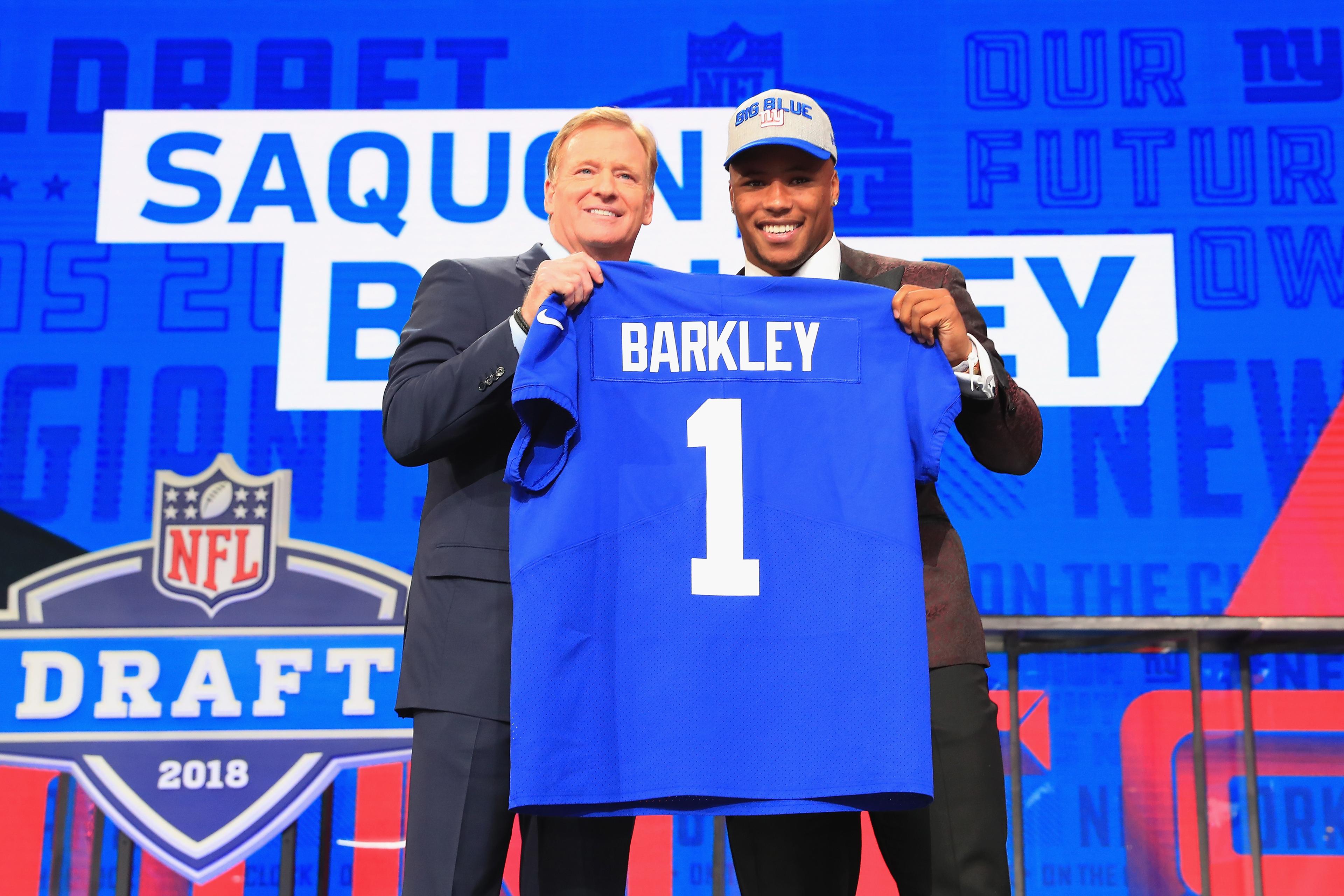
Every NFL team goes into the offseason hoping to address their most pressing needs, but free agency doesn’t always provide the answers—even if that perfect player is out there, the salary cap and competition from other clubs can leave needy teams empty-handed. That makes the draft the last, best chance to make significant upgrades—but the three-day event is a fickle beast, and can be even more unreliable than free agency because no one knows how the board will fall.
Sometimes, though, a plan just comes together. The Colts, Packers, Giants, and Patriots all came into draft weekend with major liabilities at one spot or another—and after two days of draft wheeling and dealing, each of those squads’ biggest weaknesses look like potential strengths for 2018.
Colts: Keeping Andrew Luck Upright
Indianapolis surrendered an NFL-high 56 sacks in 2017 and gave up 113 quarterback hits, good for sixth-worst league-wide. The inability to protect the most important player on the field wasn’t a new issue, either—the offensive line gave up 128 QB hits in 2016 (second-worst), 118 QB hits in 2015 (second-worst), and 107 QB hits in 2014 (fourth-worst). A lack of quality pass protection has plagued the Colts for most of Andrew Luck’s career, so assuming the three-time Pro Bowler does get back onto the field this year, it certainly behooves Indy’s front office to make sure it keeps him and his shoulder and all of his vital organs intact for a full 16 games, or more. Well, GM Chris Ballard took a big step toward that goal this week when two of his first three picks went toward the offensive line.
Taking Notre Dame guard Quenton Nelson with the sixth pick of the first round should prove to be a home run. He’s a generational prospect at the position who combines prototypical size (6-foot-5, 325 pounds) with a nasty playing style that should completely change the complexion of the Colts offensive line—hell, his demeanor could help change the identity of their whole offense. Nelson is technically sound and rarely blew a blocking assignment; he allowed just five total pressures on 411 pass-blocking snaps last year to finish with a 99.0 pass blocking efficiency score per Pro Football Focus, fifth-best among all draft eligible linemen. Dropping him in on the team’s line between veteran left tackle Anthony Castonzo and 2016 first-round center Ryan Kelly could solidify that side of the line for years to come.
But the Colts weren’t done there, and Ballard used the fifth pick of the second round (no. 37 overall) to take another offensive lineman: Auburn offensive tackle Braden Smith. Smith’s got all the traits of an immediate impact starter, too. The former high school discus and shotput star is big (6-foot-6, 315 pounds), athletic, and versatile. Like Nelson, he’s best as a run blocker, but was a technician as a pass blocker, too, allowing just six total pressures on 445 pass-blocking snaps to compile a 98.8 pass-blocking efficiency score per Pro Football Focus—ninth-best of any lineman in this class.
Add Indy’s two early picks to an offensive line group recently bolstered in free agency by veteran linemen Matt Slauson and Jack Mewhort, and, on paper, one of the team’s biggest problem areas has a chance to be one of its top strengths in 2018. Luck’s shoulder remains a major wild card, but even if Jacoby Brissett is lined up under center for the Colts in 2018, the investment in pass protectors should pay huge dividends. Brissett struggled throwing under pressure last year, compiling a 61.1 passer rating with two touchdowns and two picks, per Pro Football Focus—but when kept clean, that rating jumped over 30 points (91.5), with 11 touchdowns and five interceptions.
Packers: Slowing Down the Pass
Green Bay had one of the league’s most porous pass defenses last year, surrendering a 102.0 passer rating and 30 passing touchdowns to opposing quarterbacks—both second-worst to only the Browns. And after trading starting corner Damarious Randall (who played 717 snaps last year) to Cleveland, the Pack came into the draft in desperate need of more playmakers in the back end. They did not come out of Day 2 disappointed.
After picking up a 2019 first-rounder to trade back out of the 14th spot, the Packers’ new GM, Brian Gutekunst, traded back up to no. 18 to grab the corner they wanted all along, Louisville’s Jaire Alexander. Alexander has everything that the Packers’ struggling secondary has been missing: ball skills (seven interceptions and 15 pass breakups in his college career), elite athleticism (he posted a 4.38-second 40 time with a 6.71-second three cone and a 3.98-second short shuttle at the combine) and plenty of swagger:
The former Louisville star played in just six games last year due to injury, but made the most of his time on the field, allowing a ludicrously stingy 17.7 passer rating to opposing quarterbacks in coverage, per PFF. In fact, if you threw it Alexander’s way, he was more likely to come down with the ball than his receiver: He picked off six passes while allowing just five receptions. He projects as a day-one starter in the slot for Green Bay with the versatility to play on the outside as well. But Gutekunst wasn’t done, and with the team’s second pick (45th overall) the Packers landed a player many draft analysts considered a first-round talent, Iowa’s Josh Jackson. Jackson was a ball hawk of the highest order last year for the Hawkeyes: He picked off eight passes, deflected another 17, and gave up a quarterback rating in coverage of just 31.3. He’s got the chance to be a contributor from day one, too.
Recently signed veteran corner Tramon Williams should factor into the team’s rotation in the secondary, but after Green Bay grabbed a pair of first-round cornerback talents with its first two picks, a unit that looked threadbare coming into the draft now looks pretty stacked.
Giants: Running the Ball
It’s putting it mildly that the Giants rushing attack was underwhelming in 2017: The team finished with the 29th-ranked run game per Football Outsiders’ DVOA; tied for 22nd in yards per rush attempt (3.9), 26th in yards per game (96.8), and tied for 28th in rushing touchdowns (six). Signing free agent left tackle Nate Solder will help, but after losing out on the Andrew Norwell sweepstakes, New York came into this weekend still looking like one of the league’s worst rush offenses—and were faced with the prospect of rolling with the 31-year-old Jonathan Stewart as their bellcow (he averaged a career-low 3.4 yards per rush last year, by the way).
After the first two days of the draft, things are looking rosy in the run game department. With the second pick of the draft, new GM Dave Gettleman grabbed Penn State running back Saquon Barkley, an elite creator and playmaker who combines just about everything you look for at the position: balance, agility, vision, rare short-area burst, and home-run speed to blow by just about everyone on the field. Gettleman was just getting started, though, and used the team’s second pick, no. 34 overall, on UTEP guard Will Hernandez. When it comes to nasty, physical blockers in the run game, Hernandez might be second only in this class to Nelson, and should slot in nicely to that left guard spot the team was hoping Norwell would fill.
There’s plenty of reason to argue against heavy investments in the run game when passing is so much more efficient, but it’s hard to deny that the Giants accomplished what they set out to do.
Patriots: Protecting Tom Brady
The Patriots have made some intriguing moves this offseason, signing defensive end Adrian Clayborn, receiver Jordan Matthews, and running back Jeremy Hill while trading for defensive tackle Danny Shelton, receiver/returner Cordarrelle Patterson, and cornerback Jason McCourty. But after letting tackles Solder and Cameron Fleming walk in free agency, New England came into this weekend a few unlucky draft-board breaks away from heading into 2018 with a scary lack of depth on the offensive line and Tom Brady at 41. It put plenty of pressure on Bill Belichick and Co. to come out of the early part of the draft with a capable starter or two to add to their line.
But by the end of the draft’s second day, they’d done just that. With his first pick of the first round, Belichick went with versatile Georgia lineman Isaiah Wynn, a technically sound former left tackle who allowed just five pressures last year. And before the second round kicked off Friday night, he’d sent a third-rounder over to the 49ers in exchange for Trent Brown (and a fifth-rounder). Brown’s a mammoth right tackle (6-foot-8) who’s coming off shoulder surgery and about to enter the final year of his contract; when healthy, he’s a strong edge protector—and it wouldn’t be too surprising to see the Patriots tap into that potential this year.
In what felt like the blink of an eye, the Patriots’ distressingly shallow offensive line group suddenly looks pretty solid—and Wynn’s positional versatility (he could likely play either tackle or guard spots) gives offensive line guru Dante Scarnecchia a host of options in building out the best group of five players he’ll need to protect Brady this year.

